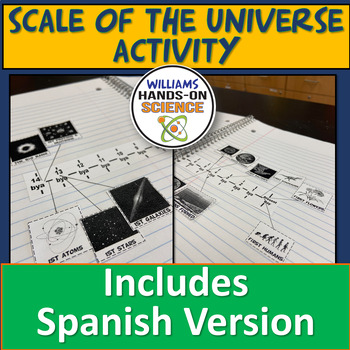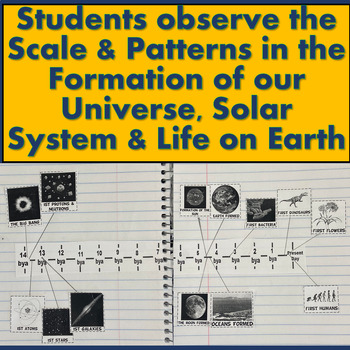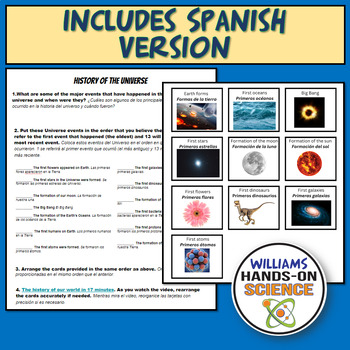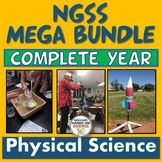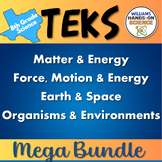NGSS Scale History of the Universe HS-ESS1-1 MS-ESS1-3 Activity Includes Spanish
- Google Slides™

Also included in
- This bundle is a time-saving, comprehensive and user-friendly complete year bundle for physical science Teachers that will streamline your teaching experience effortlessly! Every lesson is meticulously planned and just a click away. This extraordinary bundle is a treasure trove of engaging resourcesPrice $176.00Original Price $311.50Save $135.50
- The TEKS 8th Grade Bundle is a comprehensive resource for teaching science mainly in Texas, but it can be used in any state. This bundle includes over 60 hands-on, rigorous, engaging, and phenomena-driven lessons that cover the TEKS standards for 8th grade science. The lessons are designed to help sPrice $160.00Original Price $321.15Save $161.15
Description
After this activity your students will have a much deeper understanding of how our universe started and how the solar system and life evolved into what it is today! It’s interactive, inquiry based, metacognitive and integrated NGSS!!! I highly recommend you purchase The Universe and Its Stars in my store. It’s only $2.99 and it’s a perfect scaffold for this resource. Another great resource to accompany this one is Scale of the Universe. It teaches students how big objects are and their distances from earth. I teach that first and then follow up with this resource, which teaches students how everything formed.
AND! It includes a Spanish version for your ESL/ELL/Newcomer students!
You can do this lesson all online, hard copies, or a combination of both. I also have it formatted to have a notebooking option.
What Students do:
-Students use prior knowledge to guess the events that occurred from the Big Bang till now
-Students sort cards with major events on them
-As students watch a very engaging video, students rearrange the cards in the correct order.
-Students then glue cards on to a timeline that gives them a great perspective as to how the universe, matter, stars, the solar system and life on earth formed. The timeline is great a making students think critically and to recognize patterns in the formation of the universe and its stars.
Concepts Included:
Scale and Patterns
Formation & Age of the Universe
Formation of Matter
Formation of the Stars, Galaxies & Planets
Formation of the Solar System
Formation of the Earth and Life on Earth
Goldilocks Effect
This resource includes the following:
-Student Handout
-Teacher slides with detailed teacher Notes for pacing, classroom discussions and classroom management
-Cards and timeline for notebooking or handouts
-Spanish Version
NGSS Disciplinary Core Idea (DCI) Middle School:
ESS1.A: The Universe and Its Stars
• Earth and its solar system are part of the Milky Way galaxy, which is one of many galaxies in the universe. (MS-ESS1-2)
ESS1.B: Earth and the Solar System
• The solar system consists of the sun and a collection of objects, including planets, their moons, and asteroids that are held in orbit around the sun by its gravitational pull on them. (MS-ESS1-2), (MS-ESS1-3)
ESS2.A: Earth Materials and Systems
• The planet’s systems interact over scales that range from microscopic to global in size, and they operate over fractions of a second to billions of years. These interactions have shaped Earth’s history and will determine its future. (MS-ESS2-2)
NGSS Disciplinary Core Idea (DCI) High School:
ESS1.A: The Universe and Its Stars
• The star called the sun is changing and will burn out over a lifespan of approximately 10 billion years. (HS-ESS1-1)
• The study of stars’ light spectra and brightness is used to identify compositional elements of stars, their movements, and their distances from Earth. (HS-ESS1-2), (HS-ESS1-3)
• The Big Bang theory is supported by observations of distant galaxies receding from our own, of the measured composition of stars and non-stellar gases, and of the maps of spectra of the primordial radiation (cosmic microwave background) that still fills the universe. (HS-ESS1-2)
• Other than the hydrogen and helium formed at the time of the Big Bang, nuclear fusion within stars produces all atomic nuclei lighter than and including iron, and the process releases electromagnetic energy. Heavier elements are produced when certain massive stars achieve a supernova stage and explode. (HS-ESS1-2), (HS-ESS1-3)
NGSS Cross Cutting Concepts (CCC):
· Scale, Proportion and Quantity
· Systems and System Models
· Cause and Effect
· Patterns
NGSS Science and Engineering Practices (SEP):
· Analyzing and Interpreting Data
· Obtaining, Evaluating and Communicating Information.
Related Products
⭐ Bill Nye Questions Waves Electromagnetic Spectrum
⭐ Claim Evidence Reasoning (CER): Autumn Equinox Can Fall on Different Days
⭐ Crashed on the Moon
⭐ Earth, Moon and Sun PowerPoint and Guided Notes
⭐ MS-ESS1-1: Oreo Moon Phases Lab NGSS Modeling
⭐ NGSS Astronomy Resource Bundle: PowerPoint Labs Guided Notes Prezi Board Game
⭐ NGSS Black Holes & Galaxies Claim Evidence Reasoning Graphic Organizer
⭐ NGSS Claim Evidence Reasoning (CER) Big Bang Graphic Organizer
⭐ NGSS Claim Evidence Reasoning (CER) Water Found on Mars
⭐ NGSS Claim Evidence Reasoning The Mysterious Planet Nine Solar System Astronomy
⭐ NGSS Claim Evidence Reasoning: Proof That Earth Is in Its 6th Mass Extinction
⭐ NGSS Earth's Orbit Around The Sun Stop Motion Movie
⭐ NGSS Electromagnetic Spectrum Waves Doodle Notes & PowerPoint
⭐ NGSS Expanding Universe Claim Evidence Reasoning Graphic Organizer
⭐ NGSS PS2.A PS2.B PS3.A: Physics & Astronomy Critical Thinking Concept Map
⭐ NGSS Waves Electromagnetic Spectrum Properties Worksheet
⭐ NGSS Waves Light Stations Electromagnetic Phenomena
⭐ NGSS Waves Properties & Electromagnetic Spectrum Growing Resource Bundle
⭐ NGSS Waves Properties Doodle Notes Electromagnetic Spectrum PowerPoint Science
⭐ The Human Sundial
⭐ The Planets Board Game
⭐ The Sun Board Game
TERMS OF USE
• All rights reserved by Williams Hands On Science, Inc.
• This product is to be used by the original purchaser only.
• Intended for classroom and personal use only.
• Copying for more than one teacher, classroom, department, school, or school system is prohibited.
• This product may not be distributed or displayed digitally for public view.
• Failure to comply is a copyright infringement and a violation of the Digital Millennium Copyright Act (DMCA).
If there are any errors or questions, please contact me through TpT or email me at:
williamshandsonscience@gmail.com
Thank you for taking a look!
Please follow me on TpT for new products and check me out on Instagram for my products in action!
https://www.instagram.com/williams_hands_on_science/

